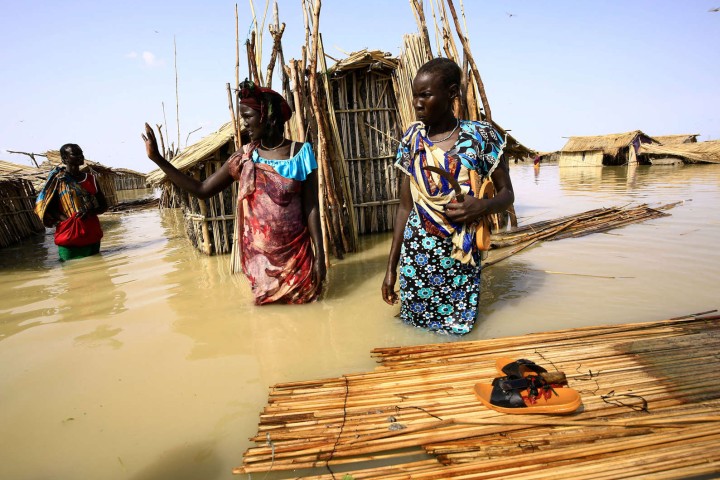The climate crisis and inequality don’t mix

There is no such thing as a “natural” disaster. A giant storm on Jupiter is not a disaster; extreme weather only causes disasters when people are exposed and vulnerable. The United Nations Climate Report that came out on Monday was the second installment in a three-part series: The first report, released in August, explained how climate change is manifesting in our atmosphere, showing that we are seeing more frequent and severe droughts, floods, storms, and heat waves around the world. This second installment explains how these manifestations of climate change are affecting people and ecosystems. It concluded that a world with communities constantly in crisis is not a world that can adapt to climate change.
Unsurprisingly, for a report titled “Impacts, Adaptation, and Vulnerability,” it found that vulnerability is the key factor in determining how climate change will affect people around the world. Climate and inequality don’t mix. In the most vulnerable regions of the world, people are 15 times more likely to die from storms, floods, and droughts than people living in resilient regions.
People are particularly vulnerable to floods, droughts, storms, and heat waves when they are unable to access basic services, such as clean water or health care. The International Committee of the Red Cross found that, of the 25 countries most vulnerable to climate change, 14 are mired in conflict.
As one of the authors on this report, I find it frustrating that there are so few studies about climate change adaptation in these conflict-affected countries, such as Yemen, South Sudan, and Myanmar. What little we do know demonstrates that people living in these complex contexts are heavily affected by extreme weather, because they are often unable to move freely, health services are limited, and their livelihoods may have already been disrupted.
To rectify this inequality between countries, there are several mechanisms to channel funding to vulnerable areas of the world, such as the Green Climate Fund. However, our report found that international commitments have fallen short of the $100 billion that was pledged for 2020 — though that $100 billion pledge is still less than what is needed. In addition, the International Committee of the Red Cross has pointed out that conflict-affected contexts receive less than their fair share of this investment.
In a national context, inequality and marginalization play a similar role in determining who is most vulnerable, and therefore most affected, by climate disasters. We have seen numerous examples of “natural” disasters in the United States that wreak devastation on low-income or marginalized populations. As we enter our future plagued with more and stronger climate shocks, I’m concerned about my own loved ones and my neighbors here in New England. None of us are invincible, and many will be hit hard by extreme storms, floods, and heat. When it comes to heat waves, for example, many elderly people or people with chronic diseases are completely unaware of their own vulnerability. In a 2009 study, Vanessa Abrahamson et al. interviewed elderly people in Britain about heat waves, and received responses such as “I don’t feel elderly and it’s very difficult to say when you become elderly,” from an 86-year-old, and that heat protection measures are “quite unnecessary. . . . I can deal with being hot,” from a 79-year-old. In fact, heat waves are the deadliest disasters in the United States, and elderly people are particularly vulnerable.
Marginalized people often benefit less from the “solutions” to climate change, as well. For example, novel crop insurance schemes tend to benefit only wealthy farmers, and sea walls are built only in wealthy areas. In many places, men have more choices available to them when they are trying to adapt to climate change, such as opportunities to take temporary work in a city. Some of these choices leave women with extra burdens. There are many examples of marginalized ethnic groups being displaced for well-intentioned new climate initiatives, such as urban “greening.”
Given these trends, one of the key messages from our report is that the solution space for climate change is not a space that can be filled with small techno-fixes. We cannot protect society from climate change simply by building bigger reservoirs. In order to survive and thrive in our changed climate, we need to address fundamental issues of inequality and marginalization, both at home and globally. We cannot afford to have a world with communities constantly in crisis.
The report describes this solution as a “climate-resilient development pathway,” one in which we invest in transformational solutions that explicitly benefit those who are most vulnerable to climate change. These can include social protection systems, access to health care, resilient food systems, and urban planning. The emphasis on a “pathway” is not an accident, because the evidence shows that a simple list of solutions does not necessarily benefit anyone. The process matters. For example, evidence shows that having everyone at the table and ensuring marginalized voices are in positions of leadership can help ensure the success of our efforts to adapt.
The intergovernmental report on climate change shows that we are all in this together: Climate change is here, it is affecting everyone, and those who are least able to cope are hardest hit. Our pathway forward is up to us.
Erin Coughlan de Perez is a climate scientist and a lead author of the Intergovernmental Panel on Climate Change Sixth Assessment Report. She is an associate professor at Tufts University and a senior advisor at the Red Cross Red Crescent Climate Centre.

